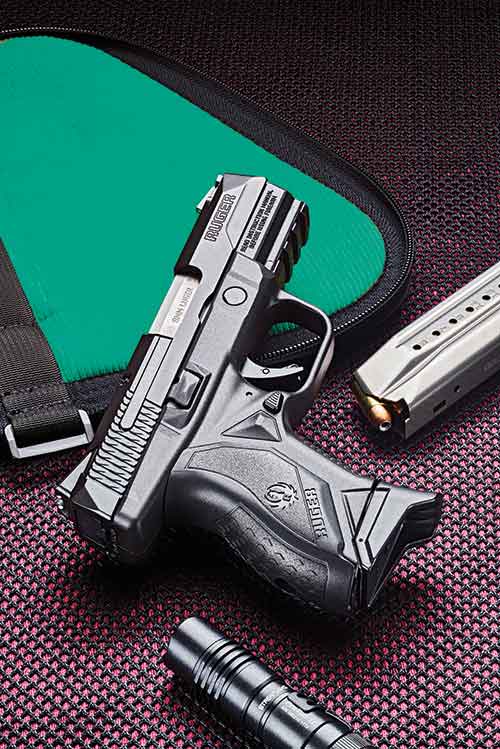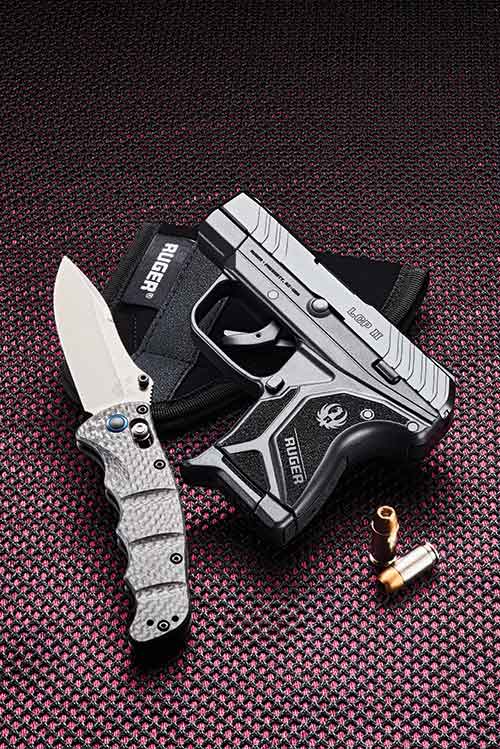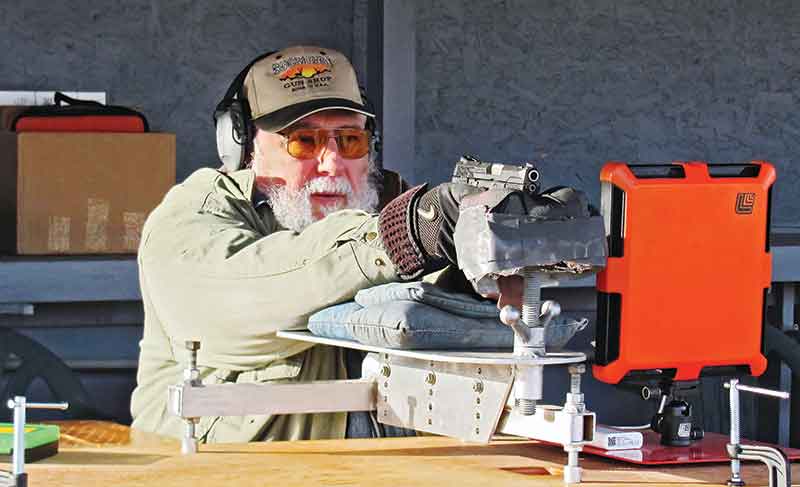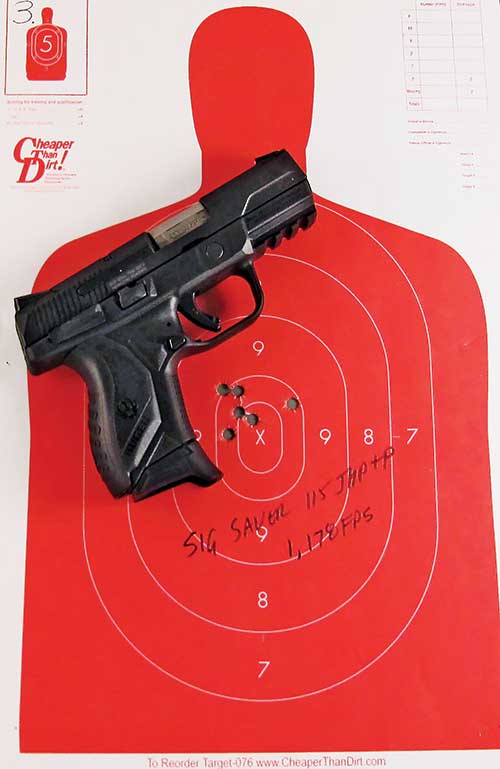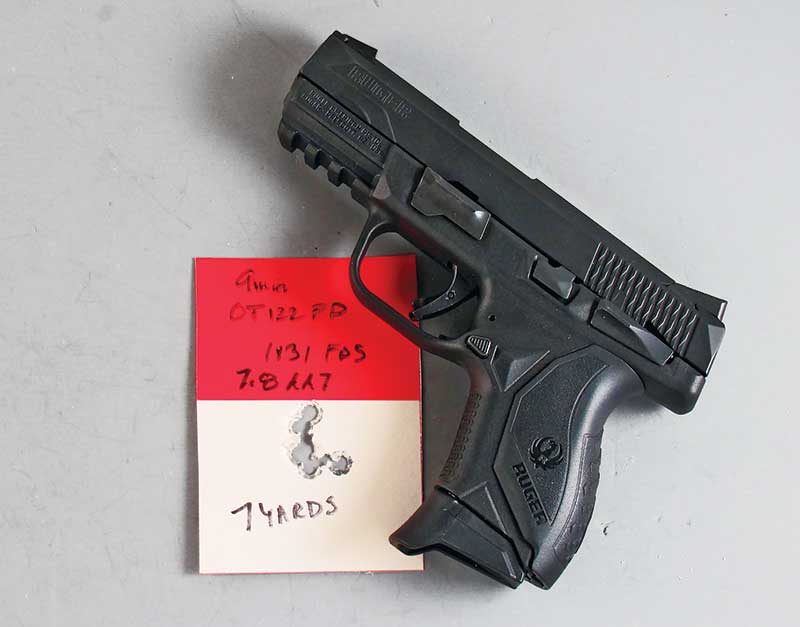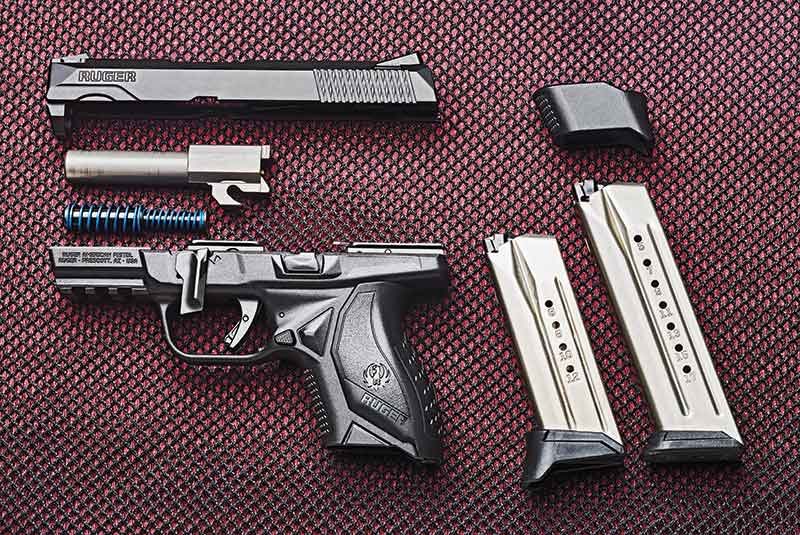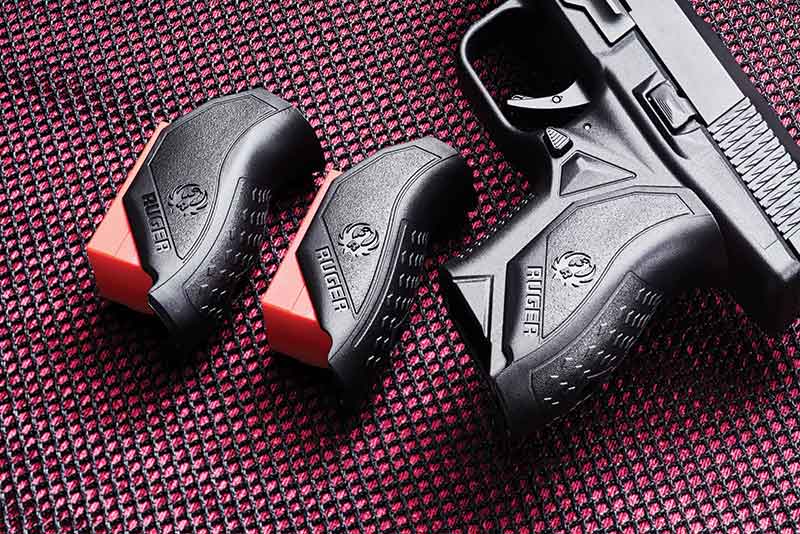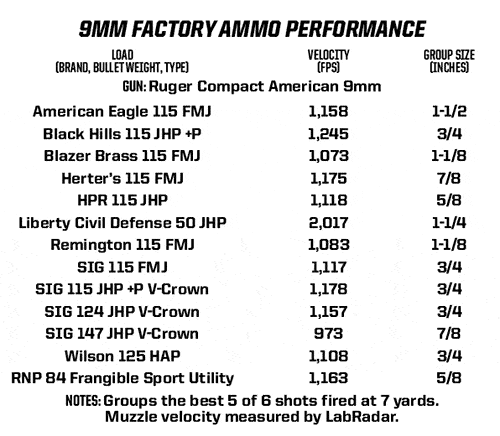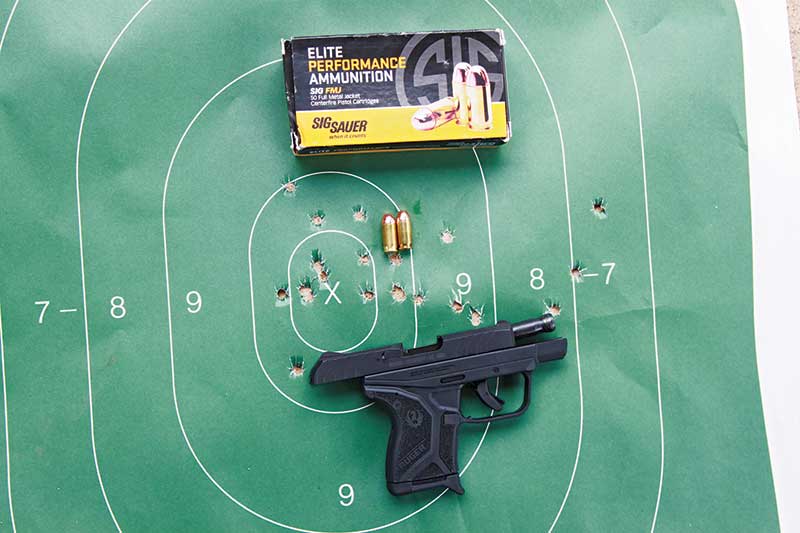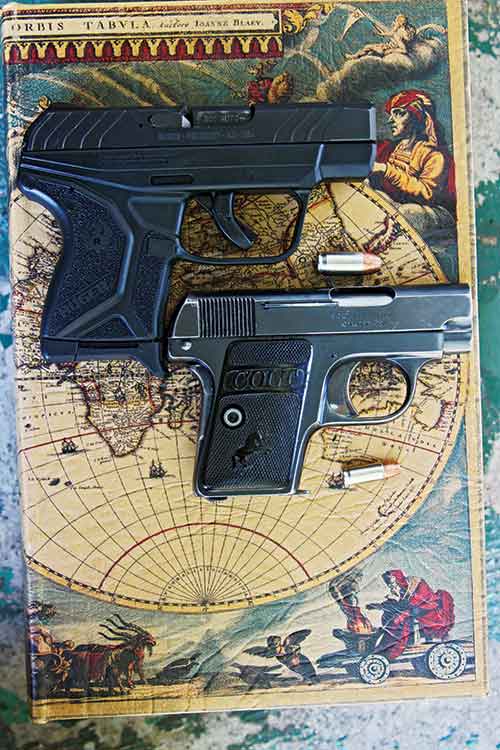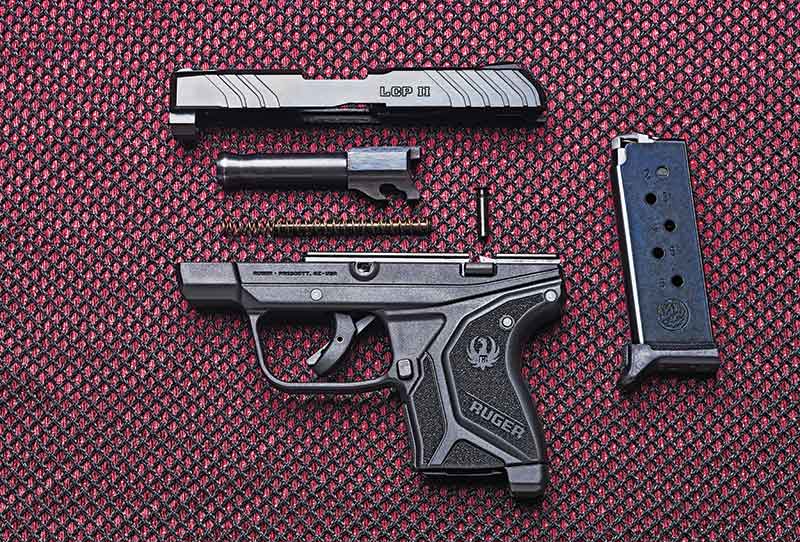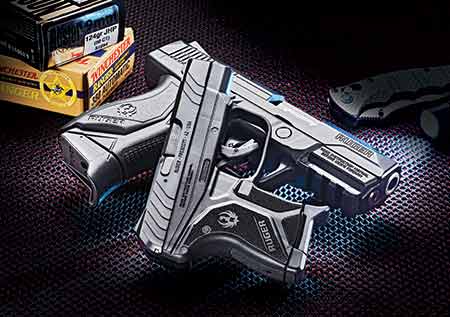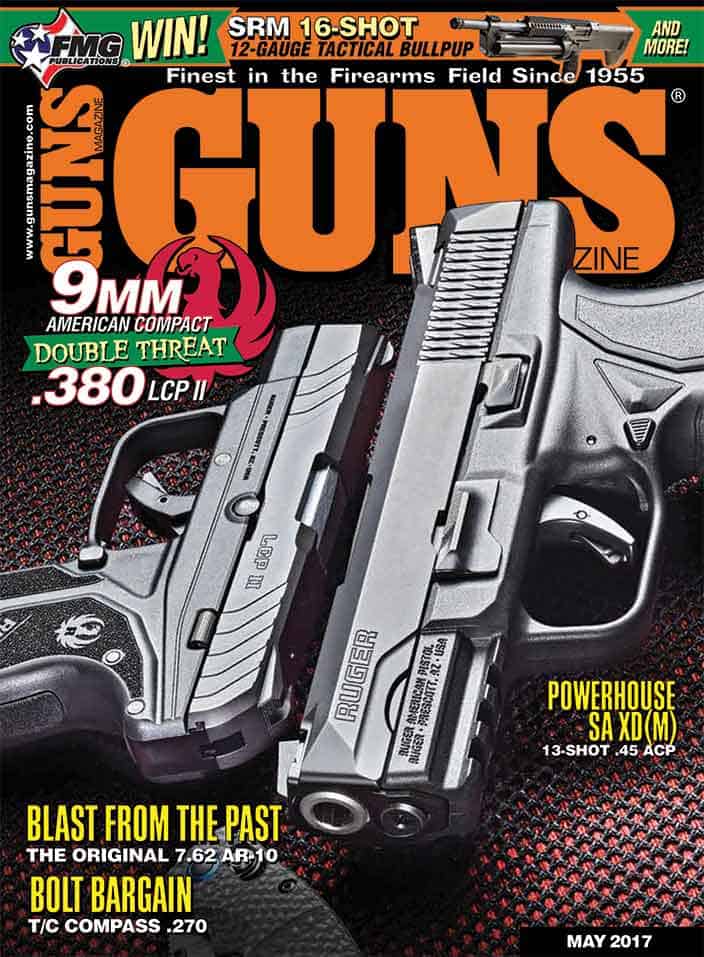Ruger Double Threat
A Scaled-Down American 9mm Or Improved
LCP .380? Take Your Pick. Or Take Both!
The American Compact 9
Ruger introduced three new semi-autos in the space of two weeks. The pistols were parceled out to three of us staff writers with my assignment being the American Compact 9, a downsized version of the full-sized American introduced two years ago. The new Compact is easier to conceal and an excellent choice for self-defense.
I have been a satisfied user of Ruger 9mm pistols for 30 years now. The first was the P85, which became generally available in 1987. I had one of the first examples. Although there were several who complained about its accuracy, I never found this to be a problem with mine. In fact, I used it the first time I was invited to take part in the Qualification Course for our local Sheriff’s Department consisting of 200 deputies. The unassuming little P85 managed to shoot a perfect score (the first one ever posted). Ruger went through several changes, offering different models of the P-series in 9mm, .40 S&W and .45 ACP over a 20-year period. In 2007 the first Ruger striker-fired polymer pistol was offered as the SR9. This was followed one year later by the pocket-sized LCP .380 ACP. In 2015 the American was introduced, which now brings us down to the American Compact 9. According to the company’s announcement:
“Sturm, Ruger & Co. Inc. is proud to introduce a 9mm (PRO and Manual Safety) compact version as a welcome addition to the Ruger American Pistol line. Introduced in a ‘Duty’ size this past January, the feature-rich and moderately priced Ruger American Pistol has already established itself as one of the best duty pistols on the market today. Designed with the latest US Military standards in mind, the gun endured torture tests in the harshest environmental conditions to prove its ruggedness and reliability. Ruger polled law enforcement and military trainers throughout the country to determine the form, function and features of this firearm. The resulting new pistol combines the recoil-reducing barrel cam (which better spreads recoil over time) with a low mass slide, lower center of gravity and the low bore axes to provide better balance, less felt recoil and less muzzle flip than comparable pistols. The Ruger American Pistol also features a pre-tensioned striker system, which allows for a short take-up trigger with positive reset, and a modular wrap-around grip system that adjusts palm swell and trigger reach to fit a wide range of hand sizes.”
With the Compact 9, all this boils down to an easy-handling, low-recoiling pistol large enough to be comfortable to shoot and small enough to conceal. It’s just over 6-1/2 inches long with a 3-1/2-inch barrel and a height of just under 4-1/2 inches. It weighs in at just under 28 ounces (unloaded). For a custom tailored feel, the Compact 9 comes with small, medium and large replaceable grip backstraps. A pair of nickel/Teflon-plated steel magazines are provided. One has a 12-round capacity while the other is an extended 17-round version with a grip extension which slips over the magazine to give a longer, more comfortable grip. I’ve shot it extensively with both magazines and I prefer to carry it with the smaller magazine with the extended magazine used as a backup. The 12-round magazine has a small extension “perch” which gives a perfect resting place for my little finger.
There’s a glass-filled nylon frame and, as Ruger says: A rigid, one-piece precision-machined, black nitrided, stainless steel chassis with integral frame rails and fire control housing.”
What this means is the frame is lightweight and the slide is stainless steel, coated with a non-glare black finish. Sights consist of a Novak LoMount Carry 3-dot setup. There is also an integral frame rail for adding a light or laser. In addition to the frame-mounted safety, there is also the typical “safety trigger” in which the center bar must be depressed before the gun will fire.
Normally when shooting slow fire or hunting with guns featuring a traditional trigger, I use the tip of my finger for better “feel” regarding trigger control, however, with these modern-style triggers it is necessary for me to use the first joint of my trigger finger for optimum control and comfort when shooting. The trigger pull on this Compact 9 measures right at 6 pounds, but feels lighter and has a short take-up with a positive reset. This means you don’t have to take your finger completely off the trigger, but with a little practice you can feel just how far forward the trigger has to go before it resets, allowing for fast action.
Cocking serrations are found on the back of the slide. To accommodate all shooters, the easily accessible frame-mounted thumb safety is ambidextrous as is the pushbutton magazine release. The magazine releases and drops positively and there is no magazine disconnect. Both front and rear sights are set in dovetails—the rear has a locking screw to allow for windage adjustment. The interchangeable backstraps and the integral front strap both have molded-in texturing for a positive grip.
Test-firing Ruger’s American Compact 9 was accomplished with 13 factory loads and my one most-used 9mm practice handload. I first started shooting at longer distances and soon found—at least in my hands—this is not a target pistol but one specifically designed for self- defense.
The Numbers Game
I then set up targets at an appropriate distance of 7 yards. This is the distance across a large room and it’s unlikely a self-defense/concealed carry pistol would ever be employed at a greater distance. My practice handload consists of the Oregon Trail 122-grain FP over 7.8 grains of AA7. This clocks out right at 1,130 fps and basically punches 1-hole groups at 7 yards in my test gun.
Ruger’s American Compact 9 is a welcome addition to my stable of self-defense pistols. I would have no problem choosing this as an everyday carry pistol or as a “house or car gun.”
Although I don’t recommend it, a friend of mine has shown just how rugged and reliable the original full-size American 9mm is. He has fired over 9,000 rounds without cleaning or lubing and the pistol continues to perform flawlessly. Ruger delivers a lot of value for a suggested retail price well under $600.
American Compact 9
Maker: Sturm, Ruger & Co.,
200 Ruger Rd,
Prescott, AZ 86301,
(928) 778-6555,
www.ruger.com
Action type: DAO semi-auto
Caliber: 9mm
Capacity: 12, 17
Barrel length: 3.55 inches
Overall length: 6.65 inches
Weight: 28.75 ounces (unloaded)
Construction: Stainless steel slide, glass-filled nylon frame
Finish: Matte black
Sights: Novak-style lo-mount 3-Dot
Grips: Integral to frame
Price: $579
The Ruger LCP II
By Mike Cumpston with Deborah Davison
Studio Photos: Takashi Sato
The basic Ruger Light Compact Pistol (LCP) came on the scene at the Shooting Hunting and Outdoor Trade show in early 2008. In a few short years, it had achieved classic status by any reasonable standard of measure. Such recognition generally arrives over a period of time propelled by excellence of design, widespread acceptance by officialdom, popular mystique and sheer numbers. Need proof? The S&W M&P revolver was the classic sidearm of the 20th Century and it took 47 years to cross the million-unit mark. The Single Action Army made by Colt for over a century hasn’t come close. Propelled by an unprecedented armed civilian movement, the original LCP, after eight years in play and relying on the civilian market alone, has sold over 1.5 million units and production is going full speed ahead meeting the demand for the LCP II.
It was certainly not lack of sales that prompted Ruger to redesign one of their most successful products. However, the company is responsive to consumer input and dedicated to customer satisfaction. The basic LCP, lightweight and thin through the grip, delivers brisk recoil which, while not painful, does often draw complaints from new shooters. The sights, while sharply defined, are a bit small and the long, heavy double-action trigger pull is more challenging than most shooters prefer.
Tweaks
The LCP II’s broader grip distributes recoil more comfortably, and the polymer frame features more comprehensive checkering. At 10.6 ounces, the LCP II gains an ounce in weight over the original and the sights, while still low profile and snag free are also highly visible. The new pistol is nominally 1/100-inch longer than the original and 1/10-inch taller—differences inconsequential to its assigned role. The trigger is substantially improved. Ours broke at 6 pounds, 12 ounces after about 3/16-inch take-up—nominally “crisp” but evidencing solid engagement of sear and hammer notch.
The pull weight on the original LCP we had on hand was essentially the same at 7 pounds, but with a long, tedious DA stroke. The trigger is connected to the sear by a drawbar keeping the action immobile as long as the trigger-mounted, frame-impinging safety is not depressed.
The firing pin spring coupled with the weight of the pistol obviates any danger of inertia discharge if the pistol is dropped on the muzzle. A chambered round is visible through an opening adjacent the extractor. The slide of the redesigned LCP II locks back on empty with the supplied magazine and will function without slide locking back with the older mags.
Initial Shooting
Fifty-foot bench-rested groups ranged from 4 to 6 inches with the loads on hand. I shot the LCP II on the standard B17 target at the distances prescribed by the Texas Handgun Qualification course of fire. All rounds fired at 3 and 7 yards stayed within the “10” and “X” rings and I drifted the 15-yard shots a bit right of center. One of the FMJ loads reliable in other pistols lacked the necessary recoil impulse and delivered a few failure-to-eject double feeds with both the LCP II and LCP. There were no other functional issues.
Side by Side
Deborah has an original LCP and considers it a fine choice for the ultimate level of concealment, but because of the long DA pull and relatively sharp recoil she doesn’t recommend it as a first gun for new shooters.
Her personal LCP wears a slip-on grip enhancer when she carries it, although we removed it for our range session. Before her first magazine went empty she was praising the new LCP II’s trigger pull. We shot both pistols side-by-side, switching back and forth at ranges of 30 and 50 feet. Both of us got about the same level of accuracy with either pistol, but our speed of delivery was significantly faster with the LCP II. Shooting comfort is improved over the original design. We settled upon 50 feet as a reasonable maximum range, then we fired a magazine each at 25 yards. We did this for fun—surprising ourselves by keeping all but one round in the scoring rings.
At the end of the day we realized we had been having fun. This is not something required or expected when shooting micro pistols, though it can be a bonus feature when the gun in question is comfortable, functions perfectly and delivers accuracy within reasonable expectations.
Deborah has no reservations about recommending the LCP II for new shooters and is considering acquiring one for personal use and as a teaching aid.
LCP II Stripping Procedure
Confirm the pistol is empty, remove the magazine and use a small screwdriver or similar sharp object to pry up and remove the assembly pin on the left side of the frame. Slide the upper unit (slide, barrel and recoil assembly) forward off the frame. Remove the spring assembly and barrel from the slide. Note the double recoil springs ride on a steel guide rod.
Some pistols arrive from the factory with visible lubrication, others are bone dry, so it’s a good idea to inspect and lubricate them prior to shooting.
To reassemble, put the barrel back in the slide, making sure the tightly wound end of the recoil springs are against the rear of the guide rod and insert the springs into the slide with the base of the rod resting on the shelf at the front of the barrel lug/cam.
Slide the upper unit to the at-rest position on the slide (this won’t work if you left the magazine in) and worry the assembly pin back in place. It will engage a tension spring with a resounding click when fully inserted.
LCP II
Maker: Sturm, Ruger & Co.,
200 Ruger Rd,
Prescott, AZ 86301,
(928) 778-6555,
www.ruger.com
Action: Enclosed hammer, single-action semi-auto
Caliber: .380 ACP
Capacity: 6+1
Barrel length: 2.75 inches
Overall length: 5.17 inches
Weight: 10.6 ounces
Construction: Glass-filled nylon frame, alloy steel slide
Finish: Blued,Sights: Low profile fixed
Price: $349
Black Hills Ammunition
P.O. Box 3090
Rapid City SD 57709
(605) 348-5150
www.black-hills.com
CCI/Speer
P.O. Box 856
Lewiston ID 83501
(800) 379-1732
www.cci-ammunition.com
Federal Cartridge Co.
900 Ehlen Dr.
Anoka MN 55303
(763) 323-2300
www.federalpremium.com
HPR Ammunition
1304 W. Red Baron Rd.
PO Box 2086
Payson AZ 85541
(928) 468-0223
Liberty Ammunition
(941) 567 6178
www.libertyammo.com
Oregon Trail Bullets
P.O. Box 529
Baker City, OR 97814
(800) 811-0548
www.oregontrailbullets.com
Remington Arms
870 Remington Dr.
P.O. Box 700
Madison, NC 27025-0700
(800) 243-9700
www.remington.com
RNP Polycase Ammunition
41 Artley Rd.
Savannah, GA 31408
SIG
72 Pease Blvd.
Newington NH 03801
(603) 418-8102
www.sigsauer.com
Wilson Combat
2452 CR 719
Berryville AR 72616
(800) 955-4856
www.wilsoncombat.com
Winchester Ammunition
600 Powder Mill Rd.
East Alton IL 62024
(618) 258-3340
www.winchester.com
